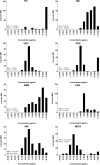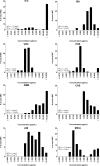Species-specific antifungal susceptibility patterns of Scedosporium and Pseudallescheria species
- PMID: 22290955
- PMCID: PMC3346635
- DOI: 10.1128/AAC.05910-11
Species-specific antifungal susceptibility patterns of Scedosporium and Pseudallescheria species
Abstract
Since the separation of Pseudallescheria boydii and P. apiosperma in 2010, limited data on species-specific susceptibility patterns of these and other species of Pseudallescheria and its anamorph Scedosporium have been reported. This study presents the antifungal susceptibility patterns of members affiliated with both entities. Clinical and environmental isolates (n = 332) from a wide range of sources and origins were identified down to species level and tested according to CLSI M38-A2 against eight antifungal compounds. Whereas P. apiosperma (geometric mean MIC/minimal effective concentration [MEC] values of 0.9, 2.4, 7.4, 16.2, 0.2, 0.8, 1.5, and 6.8 μg/ml for voriconazole, posaconazole, isavuconazole, itraconazole, micafungin, anidulafungin, caspofungin, and amphotericin B, respectively) and P. boydii (geometric mean MIC/MEC values of 0.7, 1.3, 5.7, 13.8, 0.5, 1.4, 2.3, and 11.8 μg/ml for voriconazole, posaconazole, isavuconazole, itraconazole, micafungin, anidulafungin, caspofungin, and amphotericin B, respectively) had similar susceptibility patterns, those for S. aurantiacum, S. prolificans, and S. dehoogii were different from each other. Voriconazole was the only drug with significant activity against S. aurantiacum isolates. The MIC distributions of all drugs except voriconazole did not show a normal distribution and often showed two subpopulations, making a species-based prediction of antifungal susceptibility difficult. Therefore, antifungal susceptibility testing of all clinical isolates remains essential for targeted antifungal therapy. Voriconazole was the only compound with low MIC values (MIC(90) of ≤ 2 μg/ml) for P. apiosperma and P. boydii. Micafungin and posaconazole showed moderate activity against the majority of Scedosporium strains.
Figures
References
-
- Bhat SV, Paterson DL, Rinaldi MG, Veldkamp PJ. 2007. Scedosporium prolificans brain abscess in a patient with chronic granulomatous disease: successful combination therapy with voriconazole and terbinafine. Scand. J. Infect. Dis. 39:87–90 - PubMed
-
- Brandt ME, Warnock DW. 2003. Epidemiology, clinical manifestations, and therapy of infections caused by dematiaceous fungi. J. Chemother. 15(Suppl 2):36–47 - PubMed
-
- Cimon B, et al. 2000. Clinical significance of Scedosporium apiospermum in patients with cystic fibrosis. Eur. J. Clin. Microbiol. Infect. Dis. 19:53–56 - PubMed
-
- Clinical and Laboratory and Standards Institute 2008. Reference method for broth dilution antifungal susceptibility testing of filamentous fungi. Approved standard, 2nd ed Clinical and Laboratory and Standards Institute, Wayne, PA
Publication types
MeSH terms
Substances
LinkOut - more resources
Full Text Sources
Other Literature Sources



